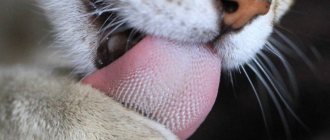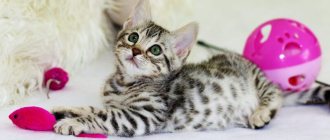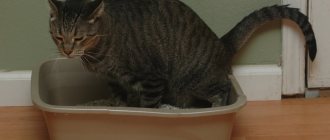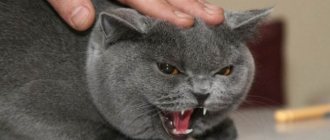Head shaking in cats can occur for a variety of reasons, both simple and more serious. In many cases, your cat's head bobbing may simply be a symptom of a benign temporary abnormality, such as a stressful situation or overheating. However, it can also be a sign of a more serious condition that may require veterinary intervention.
Sudden head shaking in felines can cause stress, but there is usually no cause for concern. In this article, we will look at the common causes of this unusual behavior in cats and possible solutions. Let's start!
Ear problems
The most common reason your cat nods his head is due to ear problems. It could be simply a buildup of wax causing discomfort or hearing problems, or it could be something more serious, such as an ear infection. An ear infection can throw your cat off balance, and rocking is her attempt to get better. This is usually accompanied by other symptoms such as vomiting and lack of appetite. Another possibility is ear mites or fleas, and persistent itching can be uncomfortable for your cat.
© shutterstock
Check your cat's ears thoroughly for wax buildup, fleas, or mites. Gently wipe away excess wax, but stay away from cotton swabs as they can damage your eardrums. If there are any signs of redness, swelling or pain, it could be an infection and you should take your cat to the vet.
How to help your pet
Options for providing assistance to the injured animal are selected after establishing the exact cause of the pathological condition.
Removing wax plugs at home
The cat begins to shake its head if it is bothered by wax plugs. You can clean your pet's ears yourself. Saline solution or hydrogen peroxide will help in this situation. The selected product is instilled into the ear canal, 2-3 drops three times a day. The treatment course lasts 7 days . Subsequently, the animal usually successfully copes with this problem on its own.
If the cat is unable to remove the plug, the owner himself can remove it using a cotton-tipped swab or a piece of gauze. As a last resort, it is recommended to contact a veterinary clinic.
Surgical intervention
This type of treatment will have to be used if a tumor or foreign object is discovered in the cat that cannot be removed in any other way.
Surgery may also be recommended in cases of chronic otitis media, which results in narrowing of the ear canal.
Feline dermatitis
Has your cat started shaking his head all the time? Perhaps he has dermatitis. The disease is treated as follows:
- Remove the crust with a piece of cotton wool or gauze using hydrogen peroxide.
- Lubricate weeping ulcers with preparations with astringent properties (“Silver nitrate” 2%).
- Place drops containing novocaine into the ear canal. This will help relieve attacks of itching.
Continue treatment until symptoms disappear completely.
Fungal infections
If the fungus has entered the cat's ears, he begins to actively shake his head. In this situation you need to act like this:
- Every day, clean the ears with Chlorhexidine (0.05% solution).
- Give the animal the antifungal drug “Ketoconazole” for internal use, dose – 5 mg per 1 kg of cat’s weight. Take twice daily.
- Otibiovin drops will have an effective effect. They need to be instilled several times a day into the pet’s ear.
© shutterstock
Fleas
If there are fleas, you need to start treatment immediately. The following steps will help get rid of parasites:
- The ear needs to be treated with a special preparation against parasites.
- After some time, clean the auricle from dead insects with a piece of cotton wool soaked in hydrogen peroxide.
- The entire cat should be thoroughly washed with flea detergent.
If necessary, the procedure must be repeated.
Ear scabies mites
This attack is treated with special antiparasitic and anti-inflammatory drugs:
- in the form of ear drops, ointment preparations (“Tactic” or “Amit”);
- in the form of injections (“Otodecnin”);
- Hydrogen peroxide and a soft tampon are used to remove purulent plaque in the ear.
Both ears must be treated at once, even if symptoms are found in only one.
How is notoedrosis treated?
Parasites must be combated with ointments and special detergents: tar, sulfur sediment, green soap.
In case of a particularly severe form of infection, use “Hyposulfite” and “Benzyl benzoate” to treat the affected areas.
If purulent formations appear, antibiotic treatment must be added.
© shutterstock
Otitis
Inflammation of the ear canal can be cured using a whole range of measures:
- if there is purulent discharge, it is removed with hydrogen peroxide and a piece of cotton wool;
- drops are instilled against otitis (Aurikan, Surolan, Oridermil, Oritsin, Bars);
- Novocaine is used to relieve pain (it is injected at the base of the animal’s ear);
- For allergic otitis, antihistamines are used.
For otitis media of a bacterial nature, the cat is treated with Otonazole, Mastiet, and Otibiovin. These are preparations for topical use.
Allergy in a cat
Animals, like people, also have allergies. Often such a reaction occurs to certain types of food or household chemicals. An allergy can be suspected if the cat shakes its ears, and at the same time its ears are clean . Treating such an ailment is simple: they use the same means that treat allergies in people (antihistamines for oral and local use).
Reaction to medications
A bad reaction to medications can cause cats to shake their head and, in severe cases, even cause seizures. Your cat may have a bad reaction to certain medications, which is quite common even with medications approved for cats. Never give your cat medications that are not prescribed or at least approved by your veterinarian, as this can cause serious side effects. Reactions to medications are often accompanied by other symptoms, such as nausea or diarrhea.
If your cat is taking medication and you suspect that this may be the cause of his head shaking, ask your veterinarian if another medication is available.
Ear cleaning
In order to prevent ear diseases and as a hygiene measure, it is necessary to clean cats' ears regularly. You can do this yourself at home, and those who are afraid or do not know how to carry out this procedure can seek help from a veterinary clinic.
The most important thing is to create a calm environment and not scare the cat. It is not necessary to hold it by force, tug and wrap it, it is enough to gently win the pet’s obedience.
Use a small piece of cotton wool to wipe the auricle from accumulated wax. Then you can drop a couple of drops of saline solution and massage your ear so that the liquid penetrates as deep as possible into the ear canal. Next, use a cotton swab to clean hard-to-reach places. Ear hygiene should be carried out at least once a month.
Genetics
Although it is quite rare, your cat's genetics may play a role in her head bobbing. This is especially common among purebred animals, where poor breeding practices among a small gene pool can result in unhealthy animals.
A good example of this is the Burmese cat. These cats sometimes suffer from an inherited condition called hypokalemic polymyopathy, which is characterized by weakness of the neck muscles that can cause head shaking.
© shutterstock
Vestibular disease
Vestibular disease is characterized by sudden and somewhat severe disorientation in cats, which may be the cause of your cat's head bobbing. Common symptoms include falling or leaning to one side, bending or shaking the head, and often nausea and vomiting. This condition is caused by an abnormality in your cat's inner ear, the vestibular system, which is responsible for balance and coordination. The exact cause of this condition is not yet fully understood and diagnosis is made based on clinical signs.
The condition usually occurs suddenly and can occur in cats of any age. Although there is no specific treatment, your veterinarian will likely prescribe antibiotics or antifungal medications since there is likely some kind of infection in the inner ear. The condition is short-lived and usually goes away within a few days.
Diagnostics
Diagnosis of vestibular diseases requires a thorough history and careful examination. To choose the direction of diagnosis, it is important to first determine whether it is a central or peripheral disorder. It is necessary to check both auditory tracts and eardrums along with an assessment of the neurological condition of the animal.
Basic laboratory tests include a complete blood count, blood chemistry panel, and urinalysis. Basic testing will also include tests for feline leukemia virus, feline immunodeficiency virus, and titers for feline coronavirus, toxoplasmosis, and cryptococcus. Evaluation of elevated immunoglobulin G titers and the presence of immunoglobulin M titers may be a sign of active toxoplasmosis infection.
X-rays of the head can help detect ear diseases by identifying changes in the tympanic bulla. However, x-ray is not a specific diagnostic method and does not show the soft tissues involved in the pathological process. New imaging techniques such as computed tomography (CT) or magnetic resonance imaging (MRI) are much better at localizing lesions in the ear or brain. MRI is particularly useful in detecting soft tissue lesions.
Because MRI is expensive, it is more often used to distinguish between central (brain) and peripheral (ear) disease after basic preliminary tests have been performed.
If encephalitis is suspected, cerebrospinal fluid (CSF) is taken for analysis. One of the most common causes of encephalitis is feline infectious peritonitis (FIP). FIP occurs primarily in cats under two years of age and is a progressive disease. The brain stem and spinal cord are the first to be affected. CSF analysis will demonstrate elevated levels of protein, predominantly globulins, and a moderate number of white blood cells, predominantly neutrophils or lymphocytes. Antibody titers or PCR virus presence may be inconclusive.
Final thoughts
Although sudden head shaking in a cat can be alarming, there is usually no serious cause for concern. The problem is usually easy to fix at home, and your cat can quickly bounce back. However, if the problem persists or worsens and is accompanied by other symptoms, it is a good idea to take your feline to a veterinarian for a check-up.
Posted by Christian Adams An American expat living in Metro Manila, Philippines for over a decade, Christian is a lifelong cat lover and the proud father of two rescue cats, Trixie and Chloe. Both girls used to be among the crowds of homeless people who roam the cities and countryside. Three-year-old Trixie was rescued from a litter found under a neighbor's porch, and two-year-old Chloe was brought home by Christian's young son, Henry, who discovered the crying kitten in the parking lot.
Pathological signs
Minor rare scratching (2-3 times a day) and head shaking cannot be called odd: all living organisms scratch and shake their heads, cats are no exception. But if the cat begins to itch constantly and at the same time tears his ears with his paws with all his might, you should pay special attention to this. These symptoms are often accompanied by other alarming signs that should alert the pet owner. These are the signs:
- The animal behaves restlessly, gets irritated and nervous for no reason.
- The cat actively shakes its head, tilts it down or to the side.
- When scratching its ears, the pet emits a hiss or an angry purr, and meows pitifully and loudly.
- Scratching left bloody marks inside and around the ears.
- The cat is trying to rub its muzzle and ears on everything around it.
- It is possible that the cat's body temperature may increase.
- The animal does not allow its ears and head to be touched, reacting painfully to any touch.
- The inner surface of the ear becomes red or swollen.
- Various discharges flow from the ear.
- Brown crusts and ulcers appeared in the ear.
Have you noticed this behavior in your cat? So it's time to see the vet.
© shutterstock











